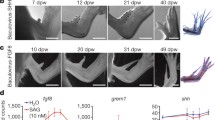Summary
Early Axolotl gastrula ectoderm was grafted into early Triturus neural stages in place of excised neural folds at the gill and anterior trunk level.
Macroscopically the young graft behaves like normal neural fold material: it follows the closing host neural plate to the dorsal midline, folds into the host's interior and, especially in the gill region, moves ventrad beneath the host's epidermis. These movements cannot be interpreted as active migration. They are the result of passive displacements by morphogenetic forces inside the embryo.
Histologically the graft differentiates into neural and neural crest tissue, the quantitative relation depending on the host's region. At the gill level the graft forms mesenchyme and other neural crest elements and hardly any neural structures. In the trunk about one half of the graft forms a secondary, surplus CNS. Problems of induction, differences between gill and trunk region and between graft and normal fold behaviour are discussed.
Limbs develop normally. The dorsal layer of the blastema is furnished by graft cells. Host and graft tissue can stay separate or form a combined blastema.
Similar content being viewed by others
References
Le Douarin NM, Teillet MA, Le Lièvre E (1977) Influence of the tissue environment on the differentiation of neural crest cells. In: JW Lash and MM Burger (ed) Cell and tissue interactions. Raven Press, New York
Harrison RG (1969) Organization and development of the embryo. New Haven and London Yale Univ. Press
Hörstadius S (1950) The neural crest. London Oxford Univ Press, 1–111
Hörstadius S, Sellmann S (1946) Experimentelle Untersuchungen über die Determination des knorpeligen Kopfskelettes bei Urodelen. Nova Acta Regiae Soc Sci Upsaliensis 13:1–170
Holtfreter J (1931) Über die Aufzucht isolierter Teile des Amphibienkeimes. W Roux' Arch 124:422–510
Horst J ter (1948) Differenzierungs- und Induktionsleistungen verschiedener Abschnitte der Medullarplatte und des Urdarmdaches von Triton im Kombinat. W Roux' Arch 143:275–303
Mangold O (1933) Über die Induktionsfähigkeit verschiedener Bezirke der Neurula von Urodelen. Naturwissenschaften 21:761–766
Raven CP (1936) Zur Entwicklung der Ganglienleiste. V. Über die Differenzierung des Rumpfganglienleistenmaterials. Arch Entw Mech Org 134:122–146
Rollhäuser-ter Horst J (1975) Neural crest and early fore limb development in Amphibia. Anat Embryol 147:337–344
Rollhäuser-ter Horst J (1977) Artificial neural induction in Amphibia. I. Sandwich explants. II. Host embryos. Anat Embryol 151:309–324
Rollhäuser-ter Horst J (1979) Artificial neural crest formation in Amphibia. Anat Embryol 157:113–120
Stone LS (1922) Experiments on the development of the cranial ganglia and the lateral — line sense organs in Ambystoma. J Exp Zool 35
Weston JA (1970) The migration and differentiation of neural crest cells. In: M Abercrombie, J Brachet, T King (ed) Advances in morphogenesis, Vol 8 Academic Press, London 41–114
Author information
Authors and Affiliations
Rights and permissions
About this article
Cite this article
Horst, J.Rt. Neural crest replaced by gastrula ectoderm in Amphibia. Anat Embryol 160, 203–211 (1980). https://doi.org/10.1007/BF00301861
Accepted:
Issue Date:
DOI: https://doi.org/10.1007/BF00301861




